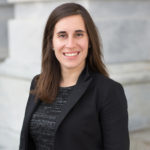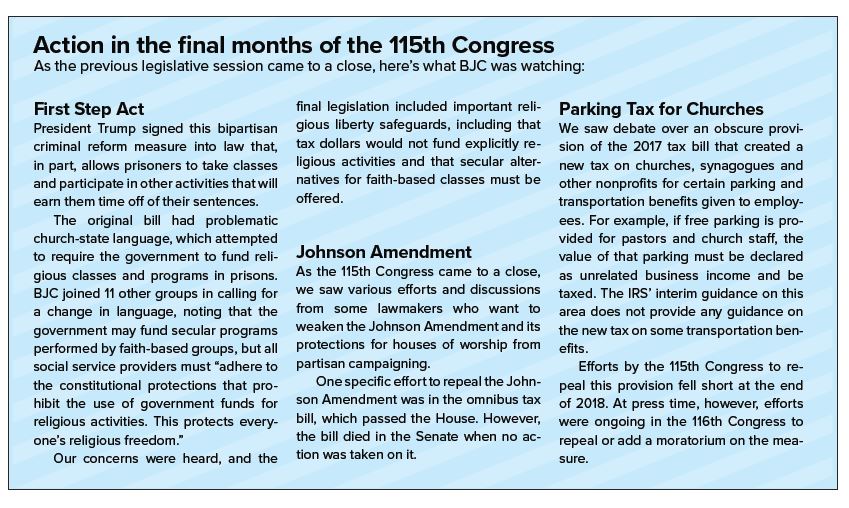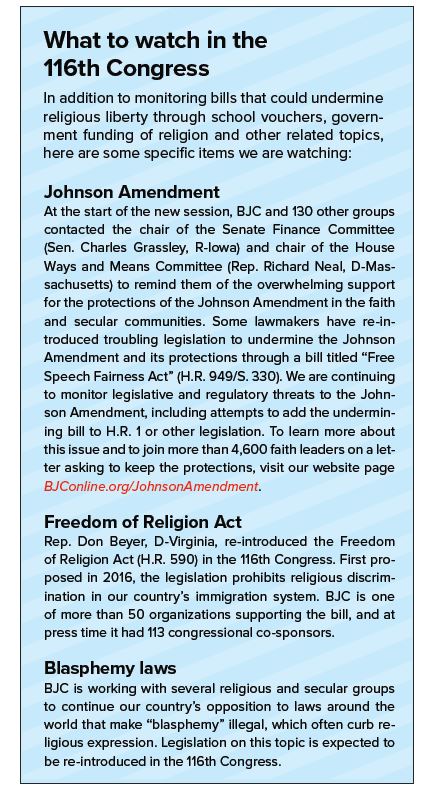
 By Ilana Ostrin, BJC Associate Director of Communications
By Ilana Ostrin, BJC Associate Director of Communications
The 116th Congress made headlines for all the diversity barriers it has broken, especially in terms of religious belief and female representation. The new Congress — whose members were sworn in on January 3 — more accurately reflects the racial and religious makeup of the United States than previous Congresses.
Notable changes
While the members of the 116th Congress remain “overwhelmingly Christian,” according to information from Pew Research, 63 members of the new Congress identify as faiths other than Christian. And, for the first time, two Muslim women were elected and sworn in as members of Congress — Rep. Ilhan Omar, D-Minnesota, and Rep. Rashida Tlaib, D-Michigan. Both took their oath of office while placing their hand on the Quran, the holy book of the Islamic faith. When swearing into a position of public office, public servants are permitted by law to swear in upon a religious text (or nonreligious text) of their choosing. According to news reports, more than a dozen different documents and books – ranging from copies of the Bible to the U.S. Constitution – were used by various members this year.
Both chambers of Congress — the House and the Senate — have about an equal numerical divide between Christians and non-Christians. But within those splits, there are some nuances. For example, all members of Congress who identify as Muslim, Hindu or Unitarian Universalist serve in the House, while no one in the Senate claims those religious beliefs.
By the numbers
Despite 23 percent of the American public claiming no faith tradition or belief, only one member of Congress, Sen. Kyrsten Sinema, D-Arizona, openly identifies as having no religious affiliation. (In the House, one member identifies as a Humanist: incumbent Rep. Jared Huffman, D-California.)
Further discrepancies exist between the American population and the religious makeup of Congress. When compared with the 115th session, the new Congress has nearly 3 percent fewer Christians, at around 88 percent. But, this is still 17 percent more than the number of Christians who make up the American population, which hovers around 71 percent.
Also showing numbers of overrepresentation are those who identify as Protestant but don’t claim to belong to any specific denomination (i.e., those who simply identify as “Christian”). Americans who identify as Christian without claiming any denomination make up only 5 percent of the U.S. population, but 15 percent of Congress. Alternatively, Pentecostals claim 5 percent of the U.S. public, but only two individual members of Congress identify as Pentecostal.
Special service
On the first day of the new Congress, members came together for a bipartisan prayer service that reflected the diversity of the lawmakers, held at St. Peter’s Catholic Church in the Capitol Hill neighborhood of Washington, D.C.
This service — which is tradition at the start of every new Congressional term — featured prayers and hymns in various languages from many of the faiths now represented in Congress. Worship music was led by Rep. Phil Roe, R-Tennessee, and Rep. Collin Peterson, D-Minnesota. Sacred texts were read, including a reading from the Hebrew Bible by Rep. Susan Wild, D-Pennsylvania; the Bhagavad Gita by Rep. Raja Krishnamoorthi, D-Illinois; the book of Psalms by Rep. Liz Cheney, R-Wyoming; and the New Testament by Rep. Jodey Arrington, R-Texas.
BJC Executive Director Amanda Tyler attended the prayer service alongside leaders of other faith-based advocacy organizations and members of Congress. “It was religious liberty at its best,” she said. “The service reflected the rich pluralism of our elected representatives and their respective faith traditions.”
Connecting with BJC
 In March, BJC volunteers and staff visited the offices of the new members of the 116th Congress, offering BJC as a resource as lawmakers are presented with questions and legislation impacting religious freedom. The volunteers delivered information on BJC’s work and priorities, including a letter from Tyler about our historic approach to religious liberty and the difficulties in today’s climate. “We are acutely aware of the challenges that attend religion in American life and the complexities surrounding the interpretation and application of constitutional and statutory protections for religious freedom, as well as the political pressures that make coming together difficult,” she wrote.
In March, BJC volunteers and staff visited the offices of the new members of the 116th Congress, offering BJC as a resource as lawmakers are presented with questions and legislation impacting religious freedom. The volunteers delivered information on BJC’s work and priorities, including a letter from Tyler about our historic approach to religious liberty and the difficulties in today’s climate. “We are acutely aware of the challenges that attend religion in American life and the complexities surrounding the interpretation and application of constitutional and statutory protections for religious freedom, as well as the political pressures that make coming together difficult,” she wrote.
Faithful impact
As religion in this country continues to change on a societal level, the foundations of religious liberty in this country and church-state separation should stay the same. As this diverse group of legislators continues to adjust to their positions and roles in the halls of power, BJC will remain committed to the principles of the First Amendment and its two religion clauses.
This article appears in the Spring 2019 edition of Report from the Capital. Download the magazine as a PDF or read a digital edition.




